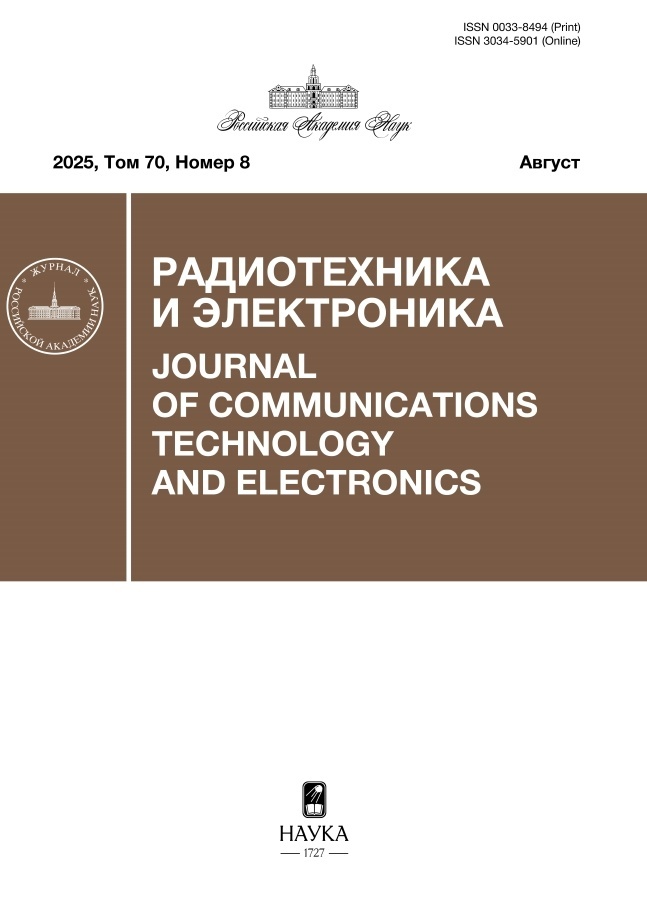Method for converting speech signal to improve speech intelligibility
- Autores: Savchenko V.V.1, Savchenko L.V.2
-
Afiliações:
- Editorial office “Radiotehnika and Electronika”
- National Research University “High School of Economics”
- Edição: Volume 70, Nº 8 (2025)
- Páginas: 753-760
- Seção: THEORY AND METHODS OF SIGNAL PROCESSING
- URL: https://genescells.com/0033-8494/article/view/692096
- DOI: https://doi.org/10.7868/S3034590125080062
- ID: 692096
Citar
Texto integral
Resumo
The task of improving the speech intelligibility in communication systems is considered. The acute problem of speaker voice recognition when using known methods for solving it is pointed out. To overcome this problem, new method for converting a speech signal is proposed. It based on an autoregressive model of the vocal tract and on the principle of frequency-selective amplification of the main formants. An example of the practical implementation of a new method based on the fast Fourier transform is considered. Estimates of computational costs and its performance are given. A full-scale experiment was set up and carried out. Based on its results, the positive effect achieved by applying the proposed method was established, namely: increasing the intelligibility of the speech of the control speaker while maintaining a sufficiently high degree of recognition of his voice. The results obtained are intended for use in the development of new and modernization of existing voice communication systems, including a mobile communication and VoIP-systems.
Sobre autores
V. Savchenko
Editorial office “Radiotehnika and Electronika”
Email: vvsavchenko@yandex.ru
Mokhovaya Str., 11, build. 7, Moscow, 125009 Russian Federation
L. Savchenko
National Research University “High School of Economics”Bol’shaya Pecherskaya Str., 25, Nizhny Novgorod, 603155 Russian Federation
Bibliografia
- Rabiner L.R., Schafer R.W. // Foundations and Trends in Signal Processing. 2007. V. 1. № 1–2. P. 1.
- Mehrish A., Majumder N., Bharadwaj R. et al. // Information Fusion. 2023. V. 99. Article No. 101869.
- Sankar M.S., Sathidevi P.S. // Circuits Systems Signal Process. 2023. V. 42. P. 3437.
- Anselam A.S., Pillai S.S., Sreeni K.G. Advances Communication Systems and Networks. Selected Proceedings of ComNet2019/Eds. by J. Jayakumari, G. K. Karagiannidis, M. Ma, S. A. Hossain. Singapore: Springer, 2020. P. 625.
- Togawa T., Otani T., Suzuki K., Taniguchi T. // APSIPA Trans. on Signal and Information Processing. 2015. V. 4. Article No. e14.
- Narendra N.P., Alku P. // Speech Commun. 2019. V. 110. P. 47.
- O’Shaughnessy D. // IEEE Trans. 2024. V. HMS-54. № 1. P. 110.
- Ngo Th., Kubo R., Akagi M. // Speech Commun. 2021. V. 135. P. 11.
- Zheng C., Zhang H., Liu W. et al. // Trends in Hearing. 2023. V. 27. Article No. 23312165231209913
- Jolad B., Khanai R. // Int. J. Speech Technology. 2023. V. 26. P. 287.
- Kolbæk M., Tan Z.H., Jensen S.H., Jensen J. // IEEE/ACM Trans. 2020. V. ASLP-28. P. 825.
- Deng F., Bao Ch. // Speech Commun. 2016. V. 79. P. 30.
- Cавченко В.В., Савченко Л.В. // РЭ. 2021. Т. 66. № 11. C. 1100.
- Cавченко В.В., Савченко Л.В. // РЭ. 2024. Т. 69. № 4. С. 339.
- Gibson J. //Information. 2019. V. 10. № 5. P. 179.
- Cавченко В.В., Савченко Л.В. // РЭ. 2023. Т. 68. № 7. С. 660.
- Ternström S. // Appl. Sciences. 2023. V. 13. № 6. P. 3514.
- Cавченко В.В., Савченко Л.В. // Измерительная техника. 2024. № 5. С. 54.
- Ito M., Ohara K., Ito A., Yano M. // Proc. 11th Annual Conf. Int. Speech Commun. Association (INTERSPEECH 2010). Makuhari. 26–30 Sept. N.Y.: Curran Associates, Inc., 2011. V.4. P. 2494.
- Cавченко А.В., Савченко В.В. // РЭ. 2022. T. 67. № 3. C. 286.
- Palaparthi A., Titze I.R. // Speech Commun. 2020. V. 123. P. 98.
- Cавченко В.В., Савченко Л.В. // Измерительная техника. 2024. № 2. C. 55.
- Tohyama M. Acoustic Signals and Hearing. A Time-Envelope and Phase Spectral Approach. L.: Academic Press, 2020. P. 89.
- Alku P., Kadiri S.R., Gowda D. // Computer Speech & Language. 2023. V. 81. Article No. 101515.
- Kathiresan Th., Maurer D., Suter H., Dellwo V. // J. Acoust. Soc. Amer. 2018. V. 143. № 3. P. 1919.
- Tokuda I.T. Oxford Research Encyclopedia of Linguistics. Oxford: Univ. Press, 2021. P. oxfordre.com/linguistics/view/10.1093/acrefore/9780199384655.001.0001/acrefore-9780199384655-e-894
- Kim H.S. Linear Predictive Coding is All-Pole Resonance Modeling. Stanford Univ. Center for Computer Research in Music and Acoustics, 2023. 7 p. ccrma.stanford.edu/~hskim08/lpc/lpc.pdf
- Jesus L., Castilho S., Ferreira A., Costa M.C. // J. Phonetics. 2023. V. 97. Article No. 101223.
- Gustafsson Ph.U., Laukka P., Lindholm T. // Speech Commun. 2023. V. 146. P. 82. https://doi.org/10.1016/j.specom.2022.12.001
- Savchenko V.V. // Radioelectronics and Communications Systems. 2021. V. 64. № 11. P. 592.
- Corey R.M., Kozat S.S., Singer A.C. Signal Processing and Machine Learning Theory/Ed. by P.S.R. Diniz. L.: Academic Press. 2024. P. 689.
- Marple S.L.Jr. Digital Spectral Analysis with Applications. Mineola: Dover Publications. 2019.
- Kuhn K., Kersken V., Reuter B. et al.// ACM Trans. on Accessible Computing. 2024. V. 16. № 4. Article No. 25
- Palani S. Principles of Digital Signal Processing. Cham: Springer 2022.
- Cавченко В.В. // Измерительная техника. 2023. № 10. С. 63.
- Cавченко В.В., Савченко А.В. // РЭ. 2020. Т. 65. № 11. С. 1101.
- Omer D.S., Hussein M.A. & Mina L.M. // J. Engineering. 2020. V. 26. № 10. P. 135.
- Esra A.J.S., Sukhi Y. // Computer Speech & Language. 2024. V. 84. Article No. 101554.
Arquivos suplementares










